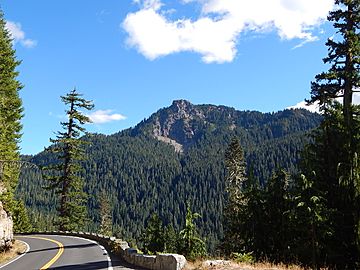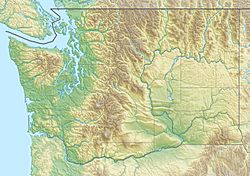Seymour Peak facts for kids
Quick facts for kids Seymour Peak |
|
|---|---|

Seymour Peak seen from Highway 123
|
|
| Highest point | |
| Elevation | 6,337 ft (1,932 m) |
| Prominence | 457 ft (139 m) |
| Geography | |
| Location | Mount Rainier National Park, Pierce County, Washington, U.S. |
| Parent range | Cascades |
| Topo map | USGS Chinook Pass |
| Climbing | |
| Easiest route | Scrambling class 3 |
Seymour Peak is a mountain peak that stands 6,337 feet (1,932 m) tall. It is located inside Mount Rainier National Park in Washington state. This peak is part of the Cascade Range, a large mountain chain. You can find it southeast of Cayuse Pass and northeast of Shriner Peak. The closest taller mountain is Dewey Peak, which is about 0.79 mi (1.27 km) to the east.
Who Was William Seymour?
Seymour Peak is named after a special person: William Wolcott Seymour (1861-1929). He was the mayor of Tacoma, Washington from 1911 to 1914. Besides being a mayor, he was also a philanthropist. This means he was a kind person who gave money and time to help others. He also loved mountaineering (climbing mountains) and helped the scouting movement grow. Water from Seymour Peak flows into streams that lead to the Cowlitz River.
What's the Weather Like at Seymour Peak?
Seymour Peak is in a place with a "marine west coast" climate. This means it gets a lot of influence from the nearby Pacific Ocean. Most of the weather systems, like clouds and rain, come from the Pacific Ocean. They travel northeast towards the Cascade Mountains.
When these weather systems hit the tall Cascade Mountains, they are forced to rise. This process is called Orographic lift. As the air rises, it cools down and drops its moisture. This moisture falls as rain or snowfall on the mountains. Because of this, the western side of the Cascades gets a lot of rain and snow, especially in winter.
During winter, it's often cloudy. But in summer, high-pressure systems over the Pacific Ocean usually bring clear skies. The snow here tends to be wet and heavy because of the ocean's influence. This can sometimes lead to a high risk of avalanches, which are large slides of snow down a mountain.
- Want to know the weather forecast for Seymour Peak? Check here: Seymour Peak Weather
- Learn more about the park: Mount Rainier National Park



